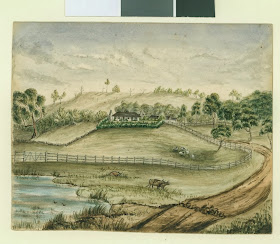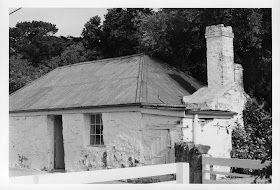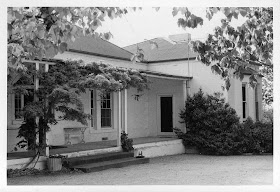From what I have seen of the earliest days of settlement along the three rivers, there were two types of squatters who came to settle "Australia Felix". All were graziers, bringing with them the stock they hoped would thrive in the new land. All were adventurers, often embarking on extended treks into territory unknown to Europeans in search of grazing land but not all came to stay.
There were those like Cowie, Stead, the von Steiglitz brothers and the Learmouths who came, established their runs over the course of the 1840s and then returned to the United Kingdom. Then there were those like Russell, Thomson, the Austins and many more who came, built permanent houses on their runs and often took on prominent roles in the communities which grew up around them.
So for this post, rather than focus on a single part of a river or a single property, I thought this time I would look at a particular person who was amongst the second group: Dugald McPherson.
 |
| Dugald McPherson. Image held by Museum Victoria |
Dugald was a Scotsman, born at Ashens, Argyllshire on 9th September, 1820. In 1840, he and his brother Peter arrived in Victoria and that same year, along with William Taylor - another Scottish immigrant - Dugald took up the squatting licence for the property
Moranghurk on the Moorabool River, about 42km from its confluence with the Barwon at Fyansford. There they ran their stock and built a small timber cottage.
They remained at Moranghurk until 1846 when, together, they made the move to the Wimmera district where they took up land. In 1848 the run was divided between the two. McPherson named his 53,000 acre run Ashens for his hometown in Scotland, whilst Taylor's run was known as Longerenong.
On the 1st June, 1852 at Melbourne, McPherson married Mary (May) O'Cock, the daughter of a St Kilda solicitor. With his new wife, Dugald returned to the Wimmera where May became the first white woman in the district, where she was considered quite a curiosity by the local indigenous population.
Only two years later however, McPherson was once again on the Moorabool River when 1854 he purchased the leasehold of John Cowie's Bungeeltap West run, presumably along with the pre-emptive right to 640 acres of land along the river which Cowie had purchased that same year.
 |
Looking northwest across the Moorabool East Branch to Bungeeltap land
from the driveway of Emly Park |
Here too the McPhersons are believed to have interacted with the local clan of the Wathaurong tribe, with Mrs McPherson reported to have witnessed a corroboree at the township on "Ballan Flat". The name Bungeeltap of course is derived from a local Wathaurong word, however I have seen two quite different meanings for the name. The first claims the meaning as "spirit water" the second, "eagle's nest". I do not know which is correct, but Bunjil (aka Bungal) was the name given to the eagle believed by the Wathaurong to be the creator spirit and who dwelt nearby at Lal Lal Falls.
Whilst not the first Europeans to settle the Bungeeltap West land, the McPhersons were the first family to call it home. In about 1863 they built a two-storey stone house in the gothic revival style, overlooking the east branch of the Moorabool River. It was at Bungeeltap homestead that their eight sons and five daughters were born. Two of the children who died in early childhood - Norman aged 3 (died 1861) and Cluny aged 4 (died in 1871) - are buried on the property. A shepherd named Tim who died from a snakebite during John Cowie's tenure in 1840 is also buried on Bungeeltap land, beside the river.
 |
| Looking north west across Bungeeltap land from the Egerton-Bungeeltap Rd |
As with most of the large squatting runs, when the land acts of the 1860s were enacted, Bungeeltap West was thrown open for selection. In addition to the land held as part of his pre-emptive right, McPherson also purchased a further 293 acres directly to the north along the river. Another 274 acres were also purchased in the name of his father-in-law, Richard O'Cock, giving a total of around 1,200 acres in family hands before the squatting licence for the property was finally relinquished in 1880.
Then in November, 1875, a notice appeared in
The Argus stating that estate agents had "...closed the sale of Emly Park Estate containing 6,700 acres...to Dugald Macpherson(sic)..." thus it seems that for a while at least, Bungeeltap East and Bungeeltap West were again held by a common owner. I cannot be sure how long Emly Park remained in McPherson's hands, however I was able to discover that in 1900, Vincent Valentine Mogg of nearby Yallock Vale purchased the property which he owned until his death in 1843.
As well as a grazier, McPherson was an innovator and was keen to improve his property and his flocks and herds. He was the first in Victoria to use an "earth scoop" also known as a "leveller" - a horse-drawn machine, guided by hand which was used to level ground for irrigation. He had his machine made at a local foundry from a drawing he had seen in a book.
Over the years, the property became known for its fine merino wool and beef cattle. Horses and horse breeding were also of interest to Dugald who it is reported, would drive a carriage and four-in-hand when visiting either Ballarat or Melbourne. At Ballarat's first national agricultural show in 1868, his horses, cattle and ewes all appeared in the prize lists and his name regularly appeared in the stock pages of the newspapers throughout the 1870s, 80s and 90s.
 |
Bungeeltap stables. Image taken 1965 by John T Collins. Image held by
The State Library of Victoria |
The McPhersons were also particularly active in the growing community at Ballan. Dugald was a councillor on the Ballan Council from 1864-1873, served as chief of the Highland Society of Ballarat and along with others was a founding member of the Australia Club in Melbourne. He was a devout Presbyterian and was the driving force and principal benefactor behind the establishment of St Paul's Presbyterian Church, Ballan which held its first service on 22nd June, 1866. The building still stands today as the Ballan Uniting Church.
 |
| Ballan Uniting Church |
Dugald's wife "presented" the central stained glass window which adorns the northern end of the church and also laid the foundation stone. Her efforts to start a Sunday school at their Bungeeltap homestead, resulted in the opening of Bungeeltap State School No. 1155 in 1875.
 |
Northern end of Ballan Uniting Church showing the window
presented by May McPherson |
Interestingly, despite their Scottish ancestry and involvement with the Presbyterian Church, at least one of Dugald and May's sons attended Geelong Church of England Grammar School and is listed amongst the old boys in a 1915 issue of the school magazine
The Corian.
In addition to their support for the church, the McPhersons appear to have taken an active role in the sporting life of the district. On 26th January, 1889 the younger members of the family were host to a cricket team made up of Ballan residents who travelled to Bungeeltap by coach to compete against a side composed of seven of the McPhersons and a few of their friends. The match was preceded by a luncheon, following which, hostilities commenced on "the well grassed flat on the banks of the Moorabool, between the Emly Park home station and Bungeeltap house" - I imagine on the Bungeeltap side. Whilst, the ladies of Bungeeltap were said to have been avid spectators at the game, Dugald does not appear to have been a participant in the match which was won comfortably by the Ballan men.
In addition to his pastoral interests at Bungeeltap, McPherson also held licences for Nhill Station in Northern Victoria and Paddington Station at Cobar in New South Wales, whilst his father-in-law Richard also moved to live near the family at Ballan. This house - known as Westcott - also passed to the McPhersons upon O'Cock's death in 1883, with one source indicating that the family used it as their town house. Between 1914 and 1930, the house was used as a private hospital and the fourth McPherson daughter died "at her residence, Westcott, Ballan" on 4th May, 1924.
 |
| The remaining portion of Westcott, Ballan |
Dugald died at Bungeeltap on 20th October, 1901, but the family remained at Bungeeltap for the next 15 years until May also died there on 14th August, 1916. She was buried in the Ballan New Cemetery with Dugald in the family grave.
 |
| McDugald family grave, Ballan New Cemetery |
Following her death, a clearing sale was held on the property, selling off the farm equipment and the property was leased out, however, the property did not remain long in family hands and by 1922, the property had been sold to William Rhodes who then undertook substantial renovation of the homestead and retained ownership of the property until his death in 1931 after which the estate passed to his widow and two children.

















































